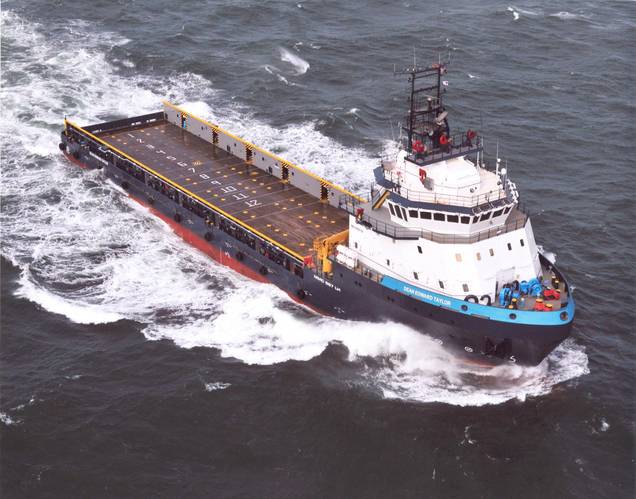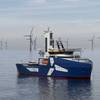Oil Majors Push Offshore Players for 30% Cuts
Smart players leverage low debt, adjust work schedules, seek spot gigs and new markets
30%That’s the minimum level of capital expenditure cuts facing owners and operators of offshore rigs, vessels and various support services, as they scramble to keep equipment working and their heads above water during one of the worst oil downturns in 30 years.
From a high of $108 per barrel in June of last year, prices plummeted roughly 60% as supply surpassed weakening demand, crashing in November to around $44 a barrel. The pricing collapse caught all sectors of the industry and financial markets by surprise, pulling down with it market valuations, quarterly earnings and day rates. OPEC, for example, earned about 14% less last year than in 2013, and experienced its lowest profits since 2010, according to the U.S Energy Information Administration (EIA). Oil company stocks have taken a beating, forcing a reassessment of spending and project plans. Rig counts have hit historic four-year lows, while long-term projects have undergone reevaluations, and in some cases, been put on hold.
The ballooning supply of oil, meanwhile continues to outstrip demand, hitting an 80-year high in the U.S., which, in late February, exclusive of the Strategic Petroleum Reserves, had 417 million barrels of oil in storage. U.S. production recently rose to a record 10.3 million barrels a day, and has consistently surpassed 9 million barrels a day since November - something that hasn’t happened since the 1970s, according to the U.S. Energy Information Agency (EIA).
That prodigious production has had the effect of positioning the U.S as one of the top oil producers on the planet, and oil’s new swing player. Along with unabated oil production elsewhere, notably in South America, the success of the U.S. shale fields has helped to drive supply levels into uncharted waters, and dangerously close to the available storage capacity for excess crude.
If production ends up exceeding storage capacity, it will force a sell off, and that in turn, could push prices lower. Adding to that downward pressure is the expectation that Iran; which is believed to be hoarding an enormous stockpile of its own – would open its floodgates if sanctions are lifted, allowing it to sell oil to the West.
OPEC, particularly the Saudis, have for decades played the arbiter of the oil market – cutting production whenever prices got too low. Not this time. The Saudis are no longer willing to cut production (and lose market share) unless everyone else – inside and out of OPEC – follows suit. Problem is, too many OPEC partners, i.e. Venezuela, Russia and Iran, desperately need the cash from oil sales. However, the Saudi gambit is expected to force a strong cutback in costly U.S. shale production, as smaller, over leveraged companies find it impossible to both get funding and to make money when oil hovers in the $40-$50+ range.
The impact is already reverberating throughout the shale industry, as rigs are cold stacked by the hundreds in record numbers, workers are laid off, existing wells are depleted and boomtowns start to panic. In six months or so, some industry watchers are predicting that a big enough drop in U.S. oil production will intersect with growing demand, pushing prices firmly back onto an upward track.
The Multi-Billion-Dollar Question
Until then, how low can oil go? That’s the question being asked everywhere. West Texas Intermediate (WTI) has dropped as low as $43 this year, and more than a few pundits think crude will head a lot lower, possibly to $30 or thereabouts, with some even suggesting $20 or less on the extreme end, before it starts to inch its way back out of the worst crash since the mid-80s. (Brent crude has mostly bounced around in the mid to upper $50s.)
If the specter of $20 oil comes to pass, it will have serious repercussions in the offshore marine markets beyond the across the board belt tightening that has already spurred layoffs, as well as idled rigs and vessels.
What could push prices down further? Well, a cresting oversupply, as noted above; a longer than expected slowdown in U.S. shale, and/or continued lower than expected demand from India, China and other parts of Asia.
Still, certain as death and taxes is the fact that eventually oil prices will rise again. The problem for the offshore industry is that it won’t be any time soon, nor possibly in the next year or two. Oil pundits and players seem to think $100 a barrel oil is five years or more down the road.
Shorter term, there is some talk of high $50s to low $60s by year-end and perhaps closer to $70-$75 a barrel by the end of 2016 or 2017.
But it doesn’t sound like oil company CEOs are buying that, and these are the guys making the big money decisions. An ExxonMobil executive told CNBC in mid-March that the company’s stock was down 10%, and that he doesn’t think oil will rebound significantly for another two years, in part because he thinks the world economy will continue to be weak through that period. In response, company CEO and Chairman Rex Tillerson said ExxonMobil will cut its 2015 capital expenditures by $4.5 billion. In late January, Royal Dutch Shell PLC said it would cut spending by $15 billion over the next three years, freeze dividends and pull back on its shale investments. Other oil companies have made similar announcements and cutbacks. Chevron CEO John Watson told CNBC, on March 27, that he expects oil prices to remain volatile and “choppy” for the rest of the year, and prices to remain depressed for several years.
“To see a 50% drop in prices [from last summer], that, I think, surprised a lot of us,” Watson said. No one saw this coming, agrees Joseph M. Bennett, executive vice president and chief investor relations officer at Tidewater, Inc., which is said to have the world’s largest fleet (261) of vessels serving the global offshore energy industry. “It was like a left hook out of nowhere. No one saw the crash of ’08 coming either.”
Regardless of what the well-capitalized oil majors and other companies believe, the plus for them is twofold. There is the potential to make some tasty acquisitions in the wake of anticipated consolidation and fire sales. The other is the opportunity to force a refocus on the basics. Oil companies have been complaining about creeping projects costs for years. The industry doldrums are the excuse they, and companies like Halliburton, which has laid off thousands, need to restructure long-term projects and cut the fat they’ve wanted to jettison anyway, say analysts like Jason Waldie, an Associate Director and energy analyst at Douglas-Westwood Pte. Ltd., in Singapore.
The End of Business as We Know It
The impact on the offshore industry has been to put an immediate end to business as usual.
“The big international oil companies – the Exxons, Shells, BPs, and national oil companies like Petrobas – are all meeting with their vendors, whoever they are – Schlumberger and Halliburton – and asking for rate diminishment,” says Tidewater’s Bennett. “They are asking for a reduction in costs, and they aren’t being bashful about it. The most common decrease they are asking for is a 30% decrease in your costs. That’s where the discussion begins.’’
“There have been rig owners, because of their supply/demand ratio, that have provided greater than a 30% reduction in day rates. We have not done that sort of thing yet. We are continuing discussions, and as the market evolves through 2015, we’ll see where that takes us,’’ says Bennett.
According to the Offshore Marine Service Association (OMSA) and Douglas Westwood’s Waldie, day rate cuts across the industry have been averaging 35%, alongside a significant contraction in capital expenditures for new projects. So even deeper water vessels and support players are feeling the pain, and the expectation is that things will get worse before they get better.
It’s too early to tell whether the crash of 2014-2015 will rival that of 1985, but people are worried. “As far as the volume of layoffs and the number of companies unable to survive in the ‘80s, we have not reached that level of seriousness yet, but the concern is very real that we may be in the early stages of this downturn,” says OMSA President Ben Billings.
The hardest hit regions have been the Gulf of Mexico, and the North Seas, where the latter has seen massive retrenchment as projects have been delayed and players like Maersk, SeaDrill and Transocean, among others, have announced cutbacks, layoffs and other measures.
“These have been historically much more spot-, than long-term work driven. In an up cycle, they are the first to benefit; in a down cycle they are the quickest to be impacted by lower, and the most severe, day rates,” says Bennett, adding his company has very little exposure in those markets. “A year and a half ago, we felt like the Gulf could be a market with an overcapacity of vessels because of the number of Jones Act vessels being built. We have 12 deep water vessels, which we teamed up with long-term contracts at the peak of the market, as opposed to others electing to play the spot market,” says Bennett. As a result, other players in the Gulf have been much more severely impacted by the downturn, he adds.
The hardest hit market sectors have been the shallow water players and the onshore shale industry in the U.S. and its supporting network of companies, which are responsible for the bulk of rigs taken offline, says Waldie.
The Best Offense is a Good Defense
The really bad news for many offshore companies wondering what to do now is that they may already be too late. The biggest lesson learned by companies who survived earlier market implosions won’t help anyone treading water today who didn’t know then what they are painfully learning now: never get carried away during the good times, and always plan ahead for the bad times.
The axiom “spend like there is no tomorrow,” takes on a different meaning for companies like Tidewater, which believe in spending like there might not be a tomorrow. “This is a very capital-intensive business. It’s very important to be very disciplined in the price you pay for individual assets. You are going to have to live with it for 20-25 years or more. In the upside years, you don’t want to spend it all and incur more debt. It will get you in trouble,” advises Bennett.
Exercising fiscal restraint as a matter of policy involves more than just not spending, or overspending on something you need. It means carefully considering the maintenance needs, and operating costs of new equipment and how that fits into a business’ long-term strategy.
A clean balance sheet, coupled with an international focus and a long-term outlook, provides the strongest tools offshore companies can use to fend off financial disaster. Beyond that, the watch words for survival strategies are “discipline” and “adaptable.”
Adaptable comes into play when looking for ways to keep both a vessel and crew in operation, include freezing wages, cutting benefits and or adapting working schedules to the available work. A 14 days on/14 days off rotation could be reworked to 10 days on/18 days off. “The worker is getting less hours, but they are still employed, and you are better prepared to respond quickly should the market pick up,” says Bennett.
When layoffs are necessary, Tidewater says the onshore positions are the first to go. Out of its 9,000 employees, 8500 are mariners. “As long as a boat is working, that is not where the reductions are coming from.”
New Builds, New Trouble?
New builds coming into delivery are a potential hot potato for some companies, as most were ordered two or more years ago when oil prices, and the demand for equipment, were high. Billings says there have been more OSVs delivered in the last couple of years than he’s seen in a long time. It’s big money, and big debt for many owners. A new platform supply vessel, for example, can cost $15-$50 million to build, cost $4,000 to $18,000 per day to run, and cost oil companies $5,000 to $42,000 per day to rent. “There has been some publically expressed concern about the possibility for overbuilding the market, and that the oversupply might be an exacerbating factor in making the current [downturn] more difficult,” he says.
According to Bennett, though, the offshore vessel industry has just about worked its way through a major new build cycle, disposing of much its older assets over the last 10-15 years. Prior to that, the last new build cycle was in the 70s. Excluding new builds, today the industry tends to have a mix of either 15-year-old vessels or 30-35-year-old vessels with a small number of 20-25-year-old boats.
Tidewater will take possession of 28 new ships over the next year and a half. “There could be better times to take delivery,” Bennett admits, but he expects to find work for all of them, even if it means cold-stacking, selling or taking a lower rate for an older vessel. There have been reports of some companies delaying acceptance of new builds or moving them right into cold storage, but he doesn’t see this being an issue. Speculative orders might have to take lower rates, but new builds feeding into long-term contracts should do okay. The rig industry, on the other hand, is not so far long in its updating cycle and that could send even more rigs off line as new ones enter the market.
Bennett sees relocating vessels to another part of the world as a viable option and something that helps his company’s survival, whether for long-term contracts or what Billings calls “short-term opportunities in spot markets.” But Walde is less optimistic. In many cases, he says, you can’t just move a vessel to another locale. Different countries have different cabotage rules, and different regions have different geographical issues to contend with. A deep water vessel would have trouble, for example, navigating through the Middle East’s shallow waters.
Other options with older assets include contracting them out at lower rates; selling them for a variety of uses, including as fishing, crabbing or cargo boats; cold stacking them; or selling them to salvage yards.
Right now, Tidewater has 16 boats cold-stacked, which involved little more than removing the crew, finding a place to drop anchor and taking the key. It’s cheap, and, Bennett says, it’s something you don’t do for a month or less. You cold stack vessels you expect to be off market for a while, eliminating labor, operating and maintenance costs.
Bennett doesn’t see the point of having two vessels working part time.
“I’d rather have one boat working 80% of the time than two boats working 50% of the time.” It’s more efficient, and cuts down on duplication of effort, labor costs and maintenance issues. He’d cold stack the vessel nearest its mandatory inspection date in order to avoid having a 1- or 3-year contract interrupted by mandatory dry dock time.
Dodging Downtime
The Offshore Marine Service Association (OMSA) is focused on making sure regulations are “efficiently managed and administered in such a way that they do not wind up jeopardizing already thin margins or jobs already at risk,” explains Ben Billings, President, OMSA.
For example, a vessel might have difficulty acquiring an inspector. If, as a result, it is required to be tied up in dock for a longer period of time, and forced to forego additional revenues during an already tight time, “it would be an issue,” says Billings. “The availability of inspectors to reduce time at the dock is always a challenging issue for everyone involved because of the thin workforce in the Coast Guard, and the high demand placed on it.”
OMSA also looks for inspection and audit issues that might be duplicative or lead to delays. “Certainly right now, when vessels need to work as many days as they possibly can, while avoiding excess time at the dock, those issues take on added significance,” says Billings.
The longer the oil crisis continues, however, the more the foremost issue for most companies will be sheer survival. For those companies saddled with debt who can do little more than curl up in a fetal position and hope their money outlasts the down market, their best hope will be acquisition or sale of their better assets. And there will be buyers, ranging from investors to big oil to fellow market competitors. Conversations are already taking place behind the scenes, say Bennett and Waldie, and the oil companies, meanwhile, have been public about their intent to look for deals and attractive fire sales.
“I’m not aware of anyone going under, but the stress levels are building day by day,” notes Bennett. But perhaps not as much at Tidewater. “We invented the offshore supply vessel market back in the mid-50s, and here we are today, still, in a very difficult market. We’re not happy with the market as it exists today, but we are pleased with the strategies we’ve employed that have put us in a good position to weather the storm.”
(As published in the April 2015 edition of Maritime Reporter & Engineering News - http://magazines.marinelink.com/Magazines/MaritimeReporter)



















